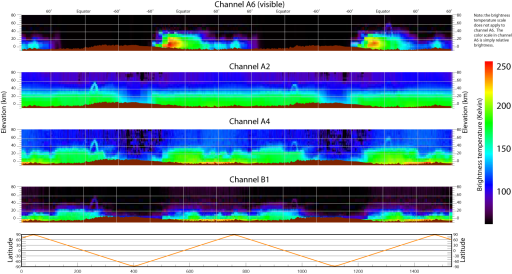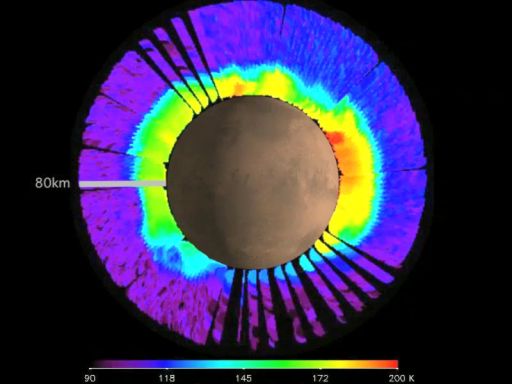Emily Lakdawalla • Jul 03, 2007
Mars Climate Sounder movies!
I've just posted some new movies made by the Mars Climate Sounder team on the team's website, which we host here at The Planetary Society. Mars Climate Sounder is not a camera, so it can be tough to visualize what their data means. Now, instead of static graphs, you can see how Mars Climate Sounder builds up a 3-D view of what's going on in Mars' atmosphere, as Mars Reconnaissance Orbiter circles the planet in its 2-hour orbit. There are two movies, representing data from different times of year, and you can see how features in Mars' atmosphere have shifted with the seasons. I don't think the Mars Climate Sounder team knows yet what changes happen every Mars season, and what changes have more to do with the kinds of chaotic weather patterns that we're so familiar with (and, often, still can't predict) on Earth.
To explain what the movies show, it might help you to look at the update on the Mars Climate Sounder instrument status that I posted earlier this year, which included a bunch of graphs that looked like this:

NASA / JPL-Caltech
Quick-look plots of Mars Climate Sounder data
This graph shows data from four of MCS's nine channels for a four-hour period starting at 12:00 UTC on October 6, 2006. Each channel surveys the Martian atmosphere vertically from about -10 to +80 kilometers above the ground (-6 to +50 miles). For the three infrared channels, A2, A4, and B1, the data is plotted as "brightness temperature," where black and blue represent the lowest brightness temperatures, and yellow and red the highest. For the visible channel A6, the data simply represents relative brightness. The data comprises slightly more than two orbits; the graph below the MCS data shows the latitude at which the measurements were taken. Mars Reconnaissance Orbiter is in a nearly polar orbit, so the spacecraft travels nearly from pole to pole. The plots begin near the north pole, where it was late summer. The most obvious feature common to all four channels is a region of low brightness temperature as Mars Reconnaissance Orbiter flew near the south pole, where it was late winter.
NASA / JPL-Caltech
Mars Climate Sounder scans in spatial context: full scanning mode
This image is a still from an animation showing the spatial context for limb scans made by Mars Climate Sounder on October 1, 2006, when Mars was in late northern summer (Ls 114). Visit the Mars Climate Sounder team website to download the movies and read more about them.Which reminds me: Mars Climate Sounder is just beginning this investigation, but that's not to say they haven't gathered much data. Mars Climate Sounder Science Manager Jim Shirley told me that as of June 20, Mars Climate Sounder has returned more than 107 -- that is to say, ten million soundings of Mars' atmosphere. By any measure, that's a huge number!
Let’s Go Beyond The Horizon
Every success in space exploration is the result of the community of space enthusiasts, like you, who believe it is important. You can help usher in the next great era of space exploration with your gift today.
Donate Today

 Explore Worlds
Explore Worlds Find Life
Find Life Defend Earth
Defend Earth

